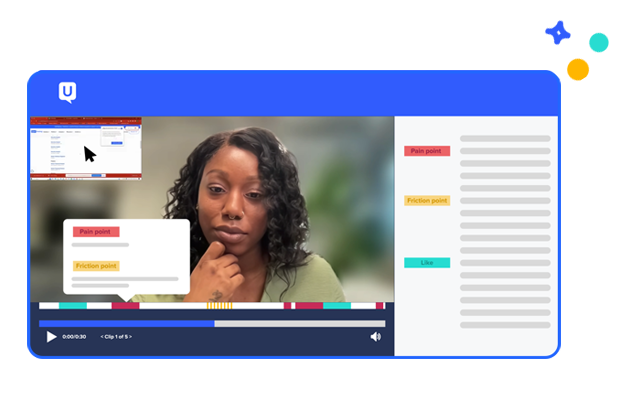
In this guide
The complete guide to usability testing
9 usability testing tips to get the most out of your research
This guide covers a lot. But before we wrap things up, we wanted to provide you with some valuable tips to remember once you start running usability tests on your own. Let's take a look.
Understanding usability testing tips
What is usability testing?
Usability testing is a cornerstone of user research, designed to evaluate the user experience of a product, website, application, or digital experience. By observing real users as they interact with your product, you can identify usability issues, gather user feedback, and pinpoint areas for improvement. The ultimate goal is to ensure that your product is intuitive, easy to use, and meets the needs of your target audience.
Various methods are available for conducting usability tests, including moderated and unmoderated sessions, remote and in-person testing, and even guerilla testing. The choice of method depends on your research objectives, budget, and available resources.
Conducting usability testing provides invaluable insights into user behavior, helping organizations make data-driven decisions. This enhances the overall user experience, boosts customer satisfaction, and drives business success.
1. Outline your objectives: create a test plan
To establish clarity and purpose in your usability testing, assemble your team members and put your heads together. Then, outline your research goals and create a comprehensive test plan. By observing real users as they interact with your product during a usability test, you can identify usability issues, gather user feedback, and pinpoint areas for improvement. Define the goals you aim to achieve through the testing process, whether uncovering usability issues, validating design decisions, or gathering feedback for iterative improvements.
Your test plan should include details such as:
- Scope of the test
- Target audience demographics
- Testing methods and UX tools
- Specific tasks or scenarios
- Criteria for success
Establish clear objectives and a structured plan to build a foundation for efficient and insightful usability tests that yield actionable results. To help structure your test plan, check out our template gallery.
2. Recruit the right test participants
Testing with real users—and the right participants—ensures you receive authentic feedback that accurately reflects your target audience's experiences.
To recruit effectively, ask screener questions to target users who match your ideal user personas and usage patterns. Seek diversity in your participant pool to capture a wide range of perspectives and experiences, which can uncover usability issues that may otherwise go unnoticed. The UserTesting Participant Network allows for demographic targeting from an extensive network of real users worldwide.
While testing with more participants can be beneficial in some cases, it's often more important to focus on recruiting a diverse group of individuals who effectively represent your target audience. Quality interactions with a smaller group usually yield more insightful feedback than larger, less focused sessions.

3. Test your test
Conducting a small-scale trial test run is crucial before launching into full-fledged usability testing, as it allows for iterative testing to refine your procedures. This process involves running through your testing procedures, tasks, and materials to identify potential issues or improvement areas. By conducting a trial test run, you can uncover logistical challenges, clarify ambiguous instructions, and confirm that your test plan is effective.
This step allows you to refine your testing process and maximize the efficiency of your usability tests, saving time and resources in the long run. Additionally, a trial test helps build confidence in your testing approach, preparing you to conduct meaningful, valuable usability testing sessions.
4. Test early and often
Incorporate testing early during the product development process. Whether you’re working with concepts, mock-ups, wireframes, prototypes, or the final product, conducting regular usability tests throughout the process can identify and address potential issues early on. Regular usability tests throughout the process help you understand user behavior and make necessary adjustments to improve the user experience.
After you’ve identified pain points and areas for improvement during the initial round of testing, don’t overlook the importance of running additional tests to validate the solutions you’ve implemented. This iterative approach allows your team to make effective changes that align with user needs and expectations.
5. Moderation techniques for usability testing
A skilled moderator can help participants feel at ease, encourage feedback, and ensure the testing process runs smoothly. Here are some strategies to keep in mind:
- Create a relaxed environment: Ensure participants feel comfortable during the testing session. A relaxed atmosphere fosters open and honest feedback.
- Use open-ended questions: Encourage participants to share their thoughts and opinions by asking open-ended questions that don’t lead to specific answers.
- Avoid leading questions: Refrain from asking questions that may influence participants’ responses or introduce bias into the testing process.
- Take notes and observe behavior: To gather qualitative data, pay close attention to participants’ behavior, body language, and verbal feedback.
- Stay neutral and objective: Maintain neutrality and objectivity throughout testing to avoid influencing participants’ responses or opinions.
Employing these moderation strategies can ensure that your usability testing sessions are productive and informative and provide valuable insights into user behavior.

6. Don't get stuck on a single method
Embrace variety and flexibility in your testing approach. To mix things up, combine methods like moderated vs. unmoderated testing, remote vs. in-person sessions, and guerilla testing.
- Moderated tests involve direct interaction between the facilitator and the test participants, allowing for real-time observation and probing for deeper insights.
- Unmoderated tests offer scalability and cost-effectiveness, letting participants complete tasks remotely while recording their interactions.
- Remote usability testing enables access to a broader pool of participants regardless of their geographical location, while in-person testing sessions provide opportunities for more nuanced observations and rapport building.
- Guerilla usability tests involve testing in informal settings with minimal preparation, offering quick and low-cost insights from diverse participants.
Combining these tests allows you to gain a unique, in-depth understanding of how users view your product.
7. Focus on listening, not leading
“Ask users to articulate their thoughts as they proceed. Even if they make the ‘right' selections, it can be very instructive to hear why they made that decision and how they respond and feel throughout the process.”
Lisa Schneider
Chief Digital Product Officer, Merriam-Webster
Strategies prioritizing listening over leading during usability testing tend to garner genuine and unbiased user feedback. Begin by asking open-ended questions to encourage participants to express their thoughts freely without influence. To maintain neutrality, refrain from passing judgment, explaining, or emphasizing specific issues or features of the product.
As participants complete the task, please encourage them to verbalize their thought process utilizing the Think Out Loud (TOL) technique. Observe users' behavior closely, noting any challenges or insights without interrupting their flow. When in doubt, clarify participant responses or actions to ensure accurate interpretation.
As you observe users interacting with your product, maintain a neutral demeanor to avoid influencing responses. Pay close attention to participants' feedback; users can uncover usability issues you might otherwise miss.
8. Analyzing and reporting results
Interpreting user testing results
Analyzing and reporting results is a critical step in the usability testing process. It involves interpreting the data you get during testing, identifying patterns and trends, and communicating findings to stakeholders. Here are some tips for analyzing and reporting results:
- Review and analyze data: Thoroughly review the data collected during testing, including participant feedback, behavioral data, and usability metrics.
- Identify patterns and trends: Look for patterns and trends in the data to identify usability issues and areas for improvement.
- Prioritize findings: Prioritize findings based on severity, frequency, and impact on the user experience.
- Create a report: Develop a comprehensive report that summarizes findings, provides recommendations, and includes visual aids such as screenshots and videos.
- Communicate findings: Effectively communicate findings to stakeholders, including designers, developers, and product managers, to ensure that usability issues are addressed and improvements are made.
By following these tips, you can ensure that your usability testing results are actionable, informative, and drive meaningful improvements to the user experience.
9. Embrace user feedback
“Usability testing is the killing field of cherished notions.”
David Orr
Paul Sears Distinguished Professor of Environmental Studies and Politics Emeritus at Oberlin College, Professor of Practice at Arizona State University
In product development, remaining objective and receptive to user feedback is vital. To avoid becoming too emotionally attached to your design, understand that its ultimate success lies in its usability and user effectiveness.
During usability testing sessions, embrace the feedback you obtain and recognize it as invaluable insight into how real users interact with your design. Then, prioritize making changes based on this feedback, even if it means deviating from your initial design vision. Remember, the primary goal is to create a user-centric product that meets its intended audience's needs and expectations.
Staying objective and responsive to user feedback ensures your design evolves to optimize usability and enhance the overall UX.
Finally, choosing the right tools is essential for conducting efficient and insightful usability testing. Explore a variety of tools and platforms to find the ones that best suit your testing objectives and budget.
Consider the platform's features, usability, scalability, and integration capabilities with your existing workflow. Look for tools that offer comprehensive analytics, customizable testing parameters, various testing templates, and a seamless participant recruitment process.

UserTesting for usability testing
Usability testing will always be an integral part of the product development lifecycle, and excellent product design will always be built on a foundation of customer listening. To instill customer-centricity across your teams, choosing the right solution that can grow with your organization is essential.
UserTesting is the industry's leading, end-to-end solution for customer feedback. From its usability and pool of participants to its functionalities, integrations, and AI features, there's no better starting point for creating an in-depth understanding of your users.

Get actionable insights today
Uncover human insights that make an impact. Book a meeting with our Sales team today to learn more.